A Spatial–Temporal Analysis and Multi-Scenario Projections of Carbon Sequestration in Sea Islands: A Case Study of Pingtan Island
Abstract
1. Introduction
2. Materials and Methods
2.1. Study Area
2.2. Data Acquisition and Preprocessing
2.3. Method
2.3.1. Dynamic Degree of Island Utilization
2.3.2. PLUS Model
2.3.3. Multi-Scenario Setting
2.3.4. InVEST Model
2.3.5. Integrated Accounting of Island Carbon Stocks
- (1)
- Accounting for marine phytoplankton carbon sinks
- (2)
- Accounting for marine fishery carbon sinks
3. Results
3.1. Impact of Island Utilization on Carbon Stocks, 2000–2020
3.1.1. Island Utilization Changes from 2006 to 2022
3.1.2. Island Carbon Stock Changes from 2006 to 2022
3.2. Multi-Scenario Projection of Carbon Stocks in 2030
3.2.1. Multi-Scenario Simulation of Island Utilization Changes
3.2.2. Carbon Stock Changes Based on Island Utilization Changes under Different Scenarios
3.3. Impact of Various Driving Factors on Island Utilization
4. Discussion
4.1. Effects of Island Utilization Changes on Carbon Stocks
4.2. Analysis of Drivers of Island Utilization Changes
4.3. Impact of Carbon Stock Changes on Social Cost of Carbon
5. Conclusions
- (1)
- From 2006 to 2022, the reclamation and urbanization of Pingtan Island led to an overall decreasing trend in carbon stocks, resulting in a cumulative economic loss of approximately USD 13.35 million. In particular, the significant expansion of land for construction has occupied a large amount of cultivated land and unutilized sea areas, leading to a significant reduction in carbon stocks. This finding emphasizes the importance of rational island resource planning for the maintenance of ecosystem carbon stocks.
- (2)
- The 2030 results show that future carbon stocks will be greater in all scenarios than in 2022, with EPS > NDS > EDS. The carbon stock under the EPS will be 595.373 × 104 t, which will be 4.270 × 104 t greater than that in 2022. This result suggests that by implementing ecological restoration policies, the carbon stock of island ecosystems can be effectively enhanced to combat climate change.
- (3)
- The analysis of the driving factors of island utilization change in 2030 reveals that the DEM will be the greatest driving factor of woodland expansion, and nighttime lighting will be the greatest indicator of construction land expansion under the three scenarios. Under the EPS, nighttime lighting will be the greatest indicator of cultivated land and unused sea area expansion. Under the NDS, the DEM will be the largest driving factor affecting cultivated land expansion. Under the EDS, nighttime lighting will be the greatest indicator of cultivated land expansion, and the DEM will be the greatest driver of unused sea area expansion.
Author Contributions
Funding
Institutional Review Board Statement
Informed Consent Statement
Data Availability Statement
Conflicts of Interest
References
- Wang, J.; Zhang, F.; Li, J.R.; Sun, M.; Sun, M.; Wang, Q.B. Analysis on the characteristics and problems of island economic development in China. Mar. Sci. Bull. 2019, 38, 250–256. [Google Scholar]
- Chowdhury, A.; Naz, A.; Maiti, S.K. Variations in Soil Blue Carbon Sequestration between Natural Mangrove Metapopulations and a Mixed Mangrove Plantation: A Case Study from the World’s Largest Contiguous Mangrove Forest. Life 2023, 13, 271. [Google Scholar] [CrossRef] [PubMed]
- Chowdhury, A.; Naz, A.; Sharma, S.B.; Dasgupta, R. Changes in Salinity, Mangrove Community Ecology, and Organic Blue Carbon Stock in Response to Cyclones at Indian Sundarbans. Life 2023, 13, 1539. [Google Scholar] [CrossRef]
- Roos, C.I.; Field, J.S.; Dudgeon, J.V. Fire activity and deforestation in Remote Oceanian islands caused by anthropogenic and climate interactions. Nat. Ecol. Evol. 2023, 7, 2028–2036. [Google Scholar] [CrossRef] [PubMed]
- Qing, W.S.; Zhang, Y.F. Research progress on island economy. Prog. Geogr. 2013, 32, 1401–1412. [Google Scholar]
- Chi, Y.; Liu, D.; Xing, W.; Wang, J. Island ecosystem health in the context of human activities with different types and intensities. J. Clean. Prod. 2021, 281, 125334. [Google Scholar] [CrossRef]
- Pata, U.K.; Kumar, A. The Influence of Hydropower and Coal Consumption on Greenhouse Gas Emissions: A Comparison between China and India. Water 2021, 13, 1387. [Google Scholar] [CrossRef]
- Sui, Y.Z.; Huang, W.G.; Zhang, H.G.; Li, S.J. Research on spatial-temporal changes in island land reclamation with remote sensing. Mar. Environ. Sci. 2013, 32, 594–598. [Google Scholar]
- Fang, Z.S.; Zhong, C.R.; Wang, F.X.; Cheng, C.; Lv, X.B.; Chen, X. Spatial-temporal evolution and prediction of ecosystem carbon storage on Hainan Island by coupling InVEST and FLUS models. Bull. Soil Water Conserv. 2023, 43, 320–329+342. [Google Scholar] [CrossRef]
- Zhang, B.F.; Zhang, J.; Miao, C.H. Urbanization level in Chinese counties: Imbalance pattern and driving force. Remote Sens. 2022, 14, 2268. [Google Scholar] [CrossRef]
- Lu, L.; Xue, Q.; Zhang, X.; Qin, C.; Jia, L. Spatiotemporal variation and quantitative attribution of carbon storage based on multiple satellite data and a coupled model for Jinan City, China. Remote Sens. 2023, 15, 4472. [Google Scholar] [CrossRef]
- Liu, Q.; Yang, D.; Cao, L.; Anderson, B. Assessment and Prediction of Carbon Storage Based on Land Use/Land Cover Dynamics in the Tropics: A Case Study of Hainan Island, China. Land 2022, 11, 244. [Google Scholar] [CrossRef]
- Yin, L.T.; Zheng, W.; Gao, M.; Lu, J.F. Coastal vulnerability of Miaodao archipelago based on InVEST model. Mar. Environ. Sci. 2021, 40, 221–227. [Google Scholar] [CrossRef]
- Zhang, M.; Lai, L.; Huang, X.J.; Chuai, X.W.; Tan, J.Z. The carbon emission intensity of land use conversion in different regions of China. Resour. Sci. 2013, 35, 792–799. [Google Scholar]
- He, Y.; Ma, J.; Zhang, C.; Yang, H. Spatio-Temporal evolution and prediction of carbon storage in Guilin based on FLUS and InVEST models. Remote Sens. 2023, 15, 1445. [Google Scholar] [CrossRef]
- Wang, R.Y.; Cai, H.; Chen, L.K.; Li, T.H. Spatiotemporal evolution and Multi-Scenario prediction of carbon storage in the GBA based on PLUS–InVEST models. Sustainability 2023, 15, 8421. [Google Scholar] [CrossRef]
- Huang, C.; Zhang, C.C.; Li, H. Assessment of the impact of rubber plantation expansion on regional carbon storage based on time series remote sensing and the InVEST model. Remote Sens. 2022, 14, 6234. [Google Scholar] [CrossRef]
- Du, S.; Zhou, Z.; Huang, D.; Zhang, F.; Deng, F.; Yang, Y. The response of carbon stocks to and use/cover change and a vulnerability Multi-Scenario analysis of the Karst region in Southern China based on PLUS-InVEST. Forests 2023, 14, 2307. [Google Scholar] [CrossRef]
- Wu, F.; Wang, Z.Y. Assessing the impact of urban land expansion on ecosystem carbon storage: A case study of the Changzhutan metropolitan area, China. Ecol. Indic. 2023, 154, 110688. [Google Scholar] [CrossRef]
- Liu, Q. Methods for the Estimation of Organic Carbon Stocks in the Upper Layer of the East China Sea by Satellite Remote Sensing. Ph.D. Thesis, Wuhan University, Wuhan, China, 2013. [Google Scholar]
- Yue, D.D.; Wang, L.M. The relationship of shellfish mariculture production and its carbon sinks in China. Jiangsu Agric. Sci. 2012, 40, 246–248. [Google Scholar] [CrossRef]
- Atwood, T.B.; Witt, A.; Mayorga, J.; Hammill, E.; Sala, E. Global patterns in marine sediment carbon stocks. Front. Mar. Sci. 2020, 7, 165. [Google Scholar] [CrossRef]
- Pata, U.K.; Erdogan, S.; Solarin, S.A.; Okumus, I. Evaluating the influence of democracy, financial development, and fishery product consumption on fishing grounds: A case study for Malaysia. Mar. Policy 2024, 168, 106301. [Google Scholar] [CrossRef]
- Li, Q.S.; Huang, J.L.; Wang, C.; Wang, B.K.; Wu, Y.J.; Zhang, J.W.; Lin, H.S.; Luo, H.H. The suitability evaluation of Pingtan Island development based on the comprehensive analysis of ecological economy and industry. Mar. Sci. 2017, 41, 1–10. [Google Scholar]
- Chen, F. Geomorphology and evolutionary development of Haitan Island. Mar. Sci. Bull. 1994, 60–66. Available online: https://kns.cnki.net/kcms2/article/abstract?v=2arE9-pF_S2PENRprq-TyMXPdoyFOKqRG3ph9iDZXjUZ_Jn-dkNOnnRd_lK33lBwKHbAYwanVZqFuJnqnVnYu9_cMz5vpmm_k5EEbqFTfgX6zqIj9M6qu6XiPaQ8xApbga8BsyRE9whMqVUhf3dqcZjpUFcM-1v5aFOCzH7EFWjUF4i9C1ghRunuKMqIUai3&uniplatform=NZKPT&language=CHS (accessed on 29 December 2023).
- Pingtan Comprehensive Experimental Zone Party Working Committee and Management Committee. Pingtan Statistical Yearkbook 2015–2022. 2023. Available online: https://www.pingtan.gov.cn/zwgk/tjxx/tjnj/ (accessed on 29 December 2023).
- Shi, M.; Wu, H.; Fan, X.; Jia, H.; Dong, T.; He, P.; Baqa, M.F.; Jiang, P. Trade-Offs and synergies of multiple ecosystem services for different land use scenarios in the Yili River Valley, China. Sustainability 2021, 13, 1577. [Google Scholar] [CrossRef]
- Wang, S.; Liu, J.; Zhang, Z.; Zhou, Q.; Zhao, X. Spatial-temporal features of land use in China. Acta Geogr. Sin. 2001, 56, 631–639. [Google Scholar]
- Li, L.; Ji, G.; Li, Q.; Zhang, J.; Gao, H.; Jia, M.; Li, M.; Li, G. Spatiotemporal evolution and prediction of ecosystem carbon storage in the Yiluo River Basin based on the PLUS-InVEST model. Forests 2023, 14, 2442. [Google Scholar] [CrossRef]
- Liang, X.; Guan, Q.; Clarke, K.C.; Liu, S.; Wang, B.; Yao, Y. Understanding the drivers of sustainable land expansion using a patch-generating land use simulation (PLUS) model: A case study in Wuhan, China. Comput. Environ. Urban Syst. 2021, 85, 101569. [Google Scholar] [CrossRef]
- Wang, C.Y.; Li, T.Z.; Guo, X.H.; Xia, L.L.; Lu, C.D.; Wang, C.B. Plus-InVEST study of the Chengdu-Chongqing urban agglomeration’s land-use change and carbon storage. Land 2022, 11, 1617. [Google Scholar] [CrossRef]
- Sun, C.; Liang, L.; Shi, Y.; Wang, Q.; Shi, J.; Wang, Y. Spatial-temporal variation analysis and prediction of carbon storage in urban ecosystems based on PLUS-InVEST model: A case study of Jiangsu Province. In Proceedings of the 2023 11th International Conference on Agro-Geoinformatics (Agro-Geoinformatics), Wuhan, China, 25–28 July 2023; pp. 1–6. [Google Scholar]
- Kupfer, J.A. Landscape ecology and biogeography: Rethinking landscape metrics in a post-FRAGSTATS landscape. Prog. Phys. Geogr.-Earth Environ. 2012, 36, 400–420. [Google Scholar] [CrossRef]
- Tian, L.; Tao, Y.; Fu, W.X.; Li, T.; Ren, F.; Li, M.Y. Dynamic simulation of land use/cover change and assessment of forest ecosystem carbon storage under climate change scenarios in Guangdong Province, China. Remote Sens. 2022, 14, 2330. [Google Scholar] [CrossRef]
- Li, F.X.; Wang, L.Y.; Chen, Z.J.; Clarke, K.C.; Li, M.C.; Jiang, P.H. Extending the SLEUTH model to integrate habitat quality into urban growth simulation. J. Environ. Manag. 2018, 217, 486–498. [Google Scholar] [CrossRef] [PubMed]
- Gao, L.; Tao, F.; Liu, R.; Wang, Z.; Leng, H.; Zhou, T. Multi-scenario simulation and ecological risk analysis of land use based on the PLUS model: A case study of Nanjing. Sustain. Cities Soc. 2022, 85, 104055. [Google Scholar] [CrossRef]
- Wang, Q.Z.; Guan, Q.Y.; Sun, Y.F.; Du, Q.Q.; Xiao, X.; Luo, H.P.; Zhang, J.; Mi, J.M. Simulation of future land use/cover change (LUCC) in typical watersheds of arid regions under multiple scenarios. J. Environ. Manag. 2023, 335, 117543. [Google Scholar] [CrossRef] [PubMed]
- Wu, Y.; Wang, J.; Gou, A. Research on the evolution characteristics, driving mechanisms and multi-scenario simulation of habitat quality in the Guangdong-Hong Kong-Macao Greater Bay based on multi-model coupling. Sci. Total Environ. 2024, 924, 171263. [Google Scholar] [CrossRef] [PubMed]
- Gao, X.; Yang, L.W.Q.; Li, C.X.; Song, S.Y.; Wang, J. Land use change and ecosystem service value measurement in Baiyangdian Basin under the simulated multiple scenarios. Acta Ecol. Sin. 2021, 41, 7974–7988. [Google Scholar]
- Sharp, R.; Douglass, J.; Wolny, S.; Arkema, K.; Bernhardt, J.; Bierbower, W.; Chaumont, N.; Denu, D.; Fisher, D.; Glowinski, K. VEST 3.9.0 User’s Guide; The Natural Capital Project; Stanford University, University of Minnesota, The Nature Conservancy, and World Wildlife Fund: Stanford, CA, USA, 2020. [Google Scholar]
- Bai, Y.; Zheng, H.; Zhuang, C.W.; Ouyang, Z.Y.; Xu, W.H. Ecosystem services valuation and its regulation in Baiyangdian baisn: Based on InVEST model. Acta Ecol. Sin. 2013, 33, 711–717. [Google Scholar]
- Wu, N.; Song, X.Y.; Kang, W.H.; Deng, X.H.; Hu, X.Q.; Shi, P.J.; Liu, Y.Q. Standard of payment for ecosystem services in a watershed based on InVEST model under different standpoints: A case study of the Weihe River in Gansu Province. Acta Ecol. Sin. 2018, 38, 2512–2522. [Google Scholar]
- Fatemeh, D.; Amir, H.; Ameneh, D.; Augusto, R.A.C.; Christine, F.; Cirella, G.T.; Morteza, N. Ecosystem services valuation using InVEST modeling: Case from southern Iranian mangrove forests. Reg. Stud. Mar. Sci. 2023, 60, 102813. [Google Scholar]
- Quan, W.; Yin, M.M.; Kang, H.J.; Zhou, Q.H.; Xu, C.L.; Zhang, C.N. Spatial distribution pattern of sediment carbon content in Dongtou offshore aquaculture waters. J. Appl. Oceanogr. 2015, 34, 580–585. [Google Scholar]
- Liano, Y.B.; Shou, L.; Zeng, J.N.; Gao, A.G.; Jiang, Z.B. A comparative study of macrobenthic community under different mariculture types in Xiangshan Bay, China. Acta Ecol. Sin. 2011, 31, 646–653. [Google Scholar]
- Ye, X.; Chen, J.; Wang, A.J.; Huang, C.B.; Wang, W.G.; Li, D.Y. Sources, burial fluxes of carbon in sediments of the western Taiwan Strait. Acta Oceanol. Sin. 2011, 33, 73–82. [Google Scholar]
- Li, X.G.; Song, J.M. Sources, transport and transformation of carbon in marine sediments. Stud. Mar. Sin. 2004, 12, 106–117. [Google Scholar]
- Dickens, A.F.; Baldock, J.A.; Smernik, R.J.; Wakeham, S.G.; Arnarson, T.S.; Gélinas, Y.; Hedges, J.I. Solid-state 13C NMR analysis of size and density fractions of marine sediments: Insight into organic carbon sources and preservation mechanisms. Geochim. Et Cosmochim. Acta 2006, 70, 666–686. [Google Scholar] [CrossRef]
- Barnes, D.K.A.; Sands, C.J. Functional group diversity is key to Southern Ocean benthic carbon pathways. PLoS ONE 2017, 12, e0179735. [Google Scholar] [CrossRef] [PubMed]
- Xu, L.; He, N.P.; Yu, G.R. A dataset of carbon density in Chinese terrestrial ecosystems (2010s). China Sci. Data 2019, 4, 90–96. [Google Scholar]
- Wang, W.J. Reserve estimation, spatiotemporal distribution and its influencing factors of soil organic carbon in Fujian Province, China. Geoscience 2019, 33, 1295–1305. [Google Scholar] [CrossRef]
- Huang, T.; Liu, S.H. Evaluation of land use change and carbon storage in Fujian Province based on PLUS-InVEST model. J. Soil Water Conserv. 2024, 38, 246–257. [Google Scholar] [CrossRef]
- Shao, E.H.; Xu, W.M.; Yang, H.; Lin, X.; Liao, Y.T. Land use simulation and carbon stock assessment in Nanping City coupled with PLUS-InVEST model. J. Hainan Univ. (Nat. Sci.) 2024, 42, 186–196. [Google Scholar] [CrossRef]
- Gao, Z.B.; Wang, X.R.; Sui, X.Y.; Wang, X.; Fang, Y.T.; Zhu, Q.; Lv, L.G. Multi-scenario predictions of habitat quality in Nanjing based on FLUS and InVEST models. J. Agric. Resour. Environ. 2022, 39, 1001–1013. [Google Scholar] [CrossRef]
- Zhang, J.; Li, X.M.; Chen, X.P.; Huang, H.; Wang, K.; Zhang, S.Y. Distribution characteristics and sources of organic matter in surface sediments along the coastal of natural seaweed beds. Mar. Sci. 2023, 47, 21–29. [Google Scholar]
- Ye, J.H.; Qiu, C.Y.; Zeng, W.X.; Shi, Y.F.; Zhao, M.Q.; Han, Q.Y. Review of organic carbon in seagrass bed sediment. Mar. Sci. 2022, 46, 130–145. [Google Scholar]
- Nie, M.C.; Huang, C.L.; Sui, Q.; Zou, L.; Zhu, L.; Sun, X.M.; Zhao, X.G.; Xia, B.; Chen, B.J.; Qu, K.M. Carbon and nitrogen stable isotope analysis and source identification of organic matter in sediments of sangou bay. Prog. Fish. Sci. 2022, 43, 84–97. [Google Scholar] [CrossRef]
- Xue, C.F.; Sheng, H.; Wei, D.Y.; Yang, Y.; Wang, Y.P.; Jia, J.J. Sediment dry weight analysis and its sedimentological significance: A case study of the East China Sea inland shelf area. Oceanol. Limnol. Sin. 2020, 51, 1093–1107. [Google Scholar]
- Cai, Y.J.; Xue, Q.j.; Lu, Y.j.; Gong, Z.J. C:N:P stoichiometry of five common macrozoobenthic taxa in shallow lakes along the Yangtze River. J. Lake Sci. 2015, 27, 76–85. [Google Scholar]
- Emerson, S.; Hedges, J.I. Processes controlling the organic carbon content of open ocean sediments. Paleoceanography 1988, 3, 621–634. [Google Scholar] [CrossRef]
- Luo, D.L.; Ruan, J.S.; Xu, C.Y.; Liao, D.Y. Concentration of the heavy metals and organic matter in surface sediments from the main shellfish culture areas of Fujian and their correlativity. Mar. Environ. Sci. 2004, 23, 33–36. [Google Scholar]
- Mao, J.; Yang, Y.F.; GU, Y.G.; Chen, S. Distribution and potential contamination assessment of biogenic elements in surface sediments from Nanao mariculture areas, Shantou. Ecol. Sci. 2012, 31, 252–258. [Google Scholar]
- Fei, Z.; Trees, C.C.; Li, B. Calculation of primary productivity using chlorophyll data. Adv. Mar. Sci. 1997, 1, 35–47. [Google Scholar]
- Wang, Q.X.; Cui, Z.G.; Qu, K.M.; Wang, Q.K.; Wei, Y.Q.; Sun, J. Advances in primary productivity and carbon biomass detection of marine phytoplankton. Mar. Sci. 2023, 47, 131–140. [Google Scholar]
- Lv, P.; Fei, Z.; Mao, X.; Zhu, M.; Zhang, K.; Liu, Y.; Li, B.; Xia, B. Estimation of chlorophyll-a distribution and primary productivity in the Bohai Sea. Haiyang Xuebao 1984, 6, 90–98. [Google Scholar]
- Zhao, S.H.; Ye, Y.H.; Luo, F.; Yang, M.C.; Zhang, Y.; Sun, F.F. Preliminary study on carbon sequestration accounting in Shenzhen offshore area. Environ. Sci. Technol. 2019, 42, 140–147. [Google Scholar] [CrossRef]
- Ministry of Natural Resources. The Marine Carbon Sink Accounting Methodology. 2023. Available online: http://aoc.ouc.edu.cn/2023/0302/c15169a424717/pagem.htm (accessed on 25 December 2023).
- Yu, Y.; Guo, B.; Wang, C.; Zang, W.; Huang, X.; Wu, Z.; Xu, M.; Zhou, K.; Li, J.; Yang, Y. Carbon storage simulation and analysis in Beijing-Tianjin-Hebei region based on CA-plus model under dual-carbon background. Geomat. Nat. Hazards Risk 2023, 14, 2173661. [Google Scholar] [CrossRef]
- He, D.; Jin, F.J.; Zhou, J. The changes of land use and landscape pattern based on Logistic-CA-Markov Model—A case study of Beijing-Tianjin-Hebei metropolitan region. Sci. Geogr. Sin. 2011, 31, 903–910. [Google Scholar] [CrossRef]
- Zou, M.; Wu, Q.Y.; Pang, J.W. Analysis of the land use spatial pattern and spatio-temporal changes in the area of Longkou based on DEM. Sci. Surv. Mapp. 2007, 32, 173–175. [Google Scholar]
- Xu, K.N.; Chen, F.L.; Liu, X.Y. The reality of China’s economic growth: A test based on global nighttime lights data. Econ. Res. J. 2015, 50, 17–29+57. [Google Scholar]
- Zhang, y.; Jiang, B.; Zhao, Y.H.; Zhao, Y. Study on carbon emission effect of urban land use in Northeast China based on land use change. Environ. Sci. Technol. 2022, 45, 209–217. [Google Scholar] [CrossRef]
- Nicholls, R.J.; Lincke, D.; Hinkel, J.; Brown, S.; Vafeidis, A.T.; Meyssignac, B.; Hanson, S.E.; Merkens, J.-L.; Fang, J. A global analysis of subsidence, relative sea-level change and coastal flood exposure. Nat. Clim. Chang. 2021, 11, 338–342. [Google Scholar] [CrossRef]
- Tol, R.S.J. A social cost of carbon for (almost) every country. Energy Econ. 2019, 83, 555–566. [Google Scholar] [CrossRef]
- Rennert, K.; Errickson, F.; Prest, B.C.; Rennels, L.; Newell, R.G.; Pizer, W.; Kingdon, C.; Wingenroth, J.; Cooke, R.; Parthum, B.; et al. Comprehensive evidence implies a higher social cost of CO2. Nature 2022, 610, 687–692. [Google Scholar] [CrossRef] [PubMed]
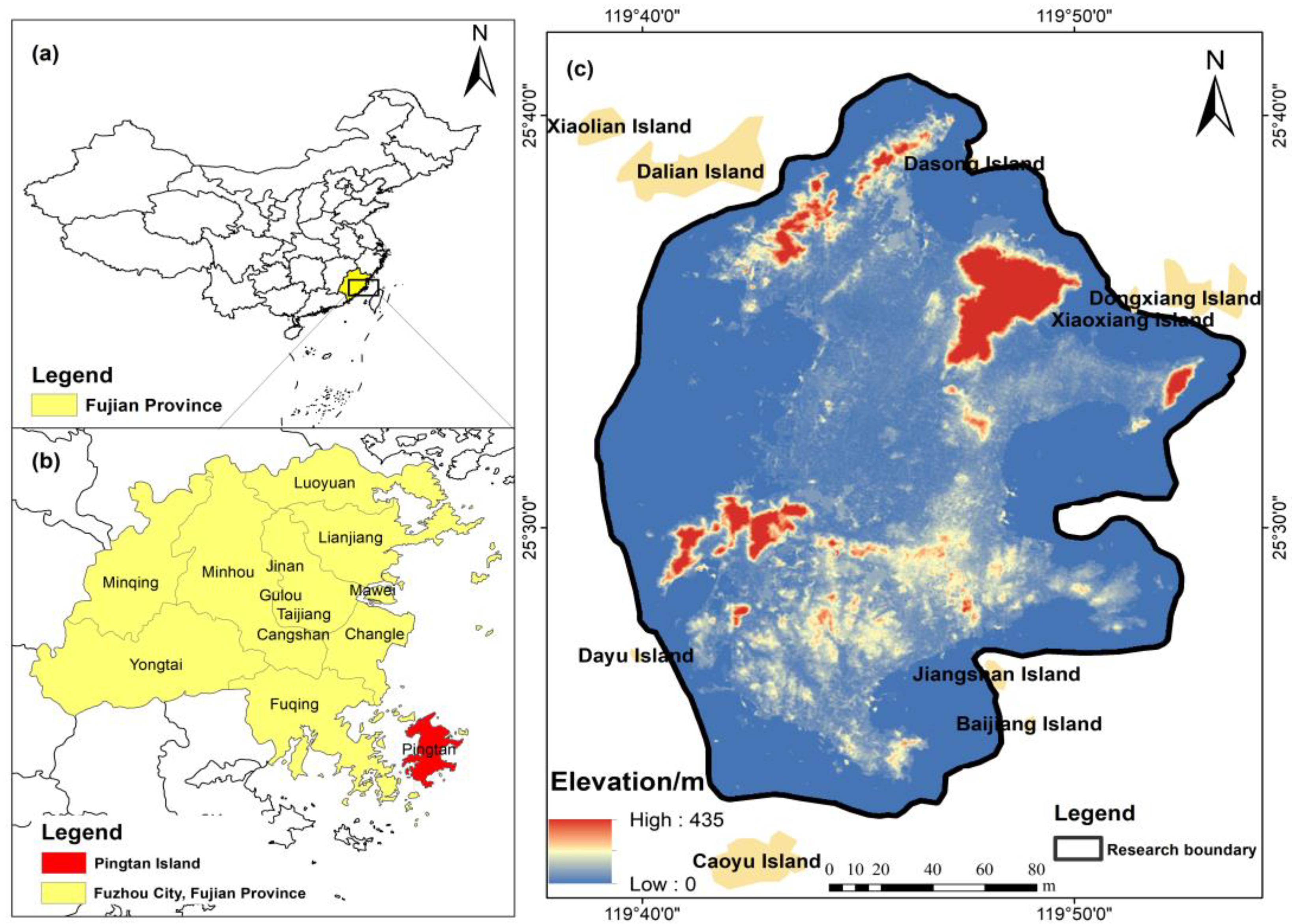
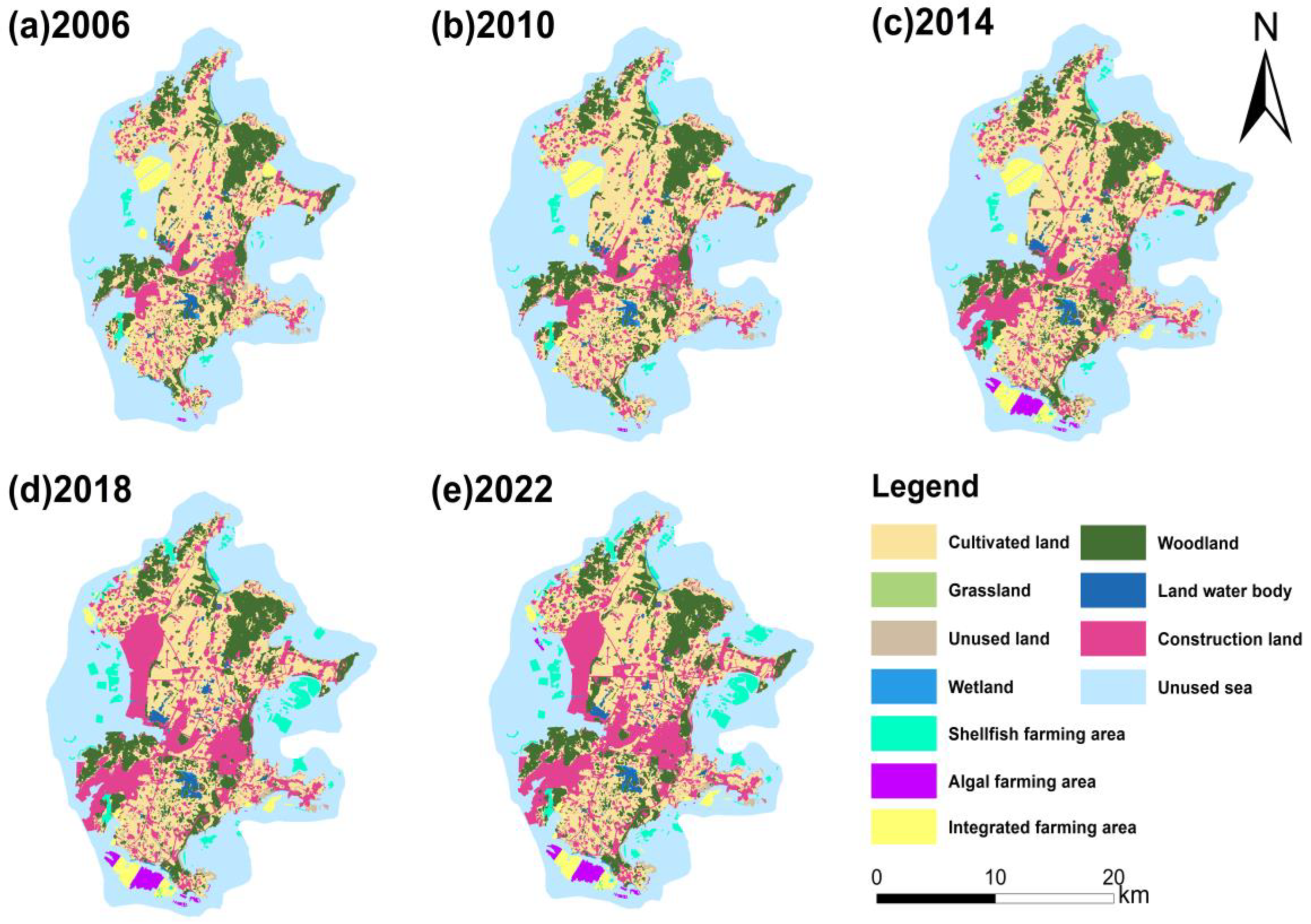
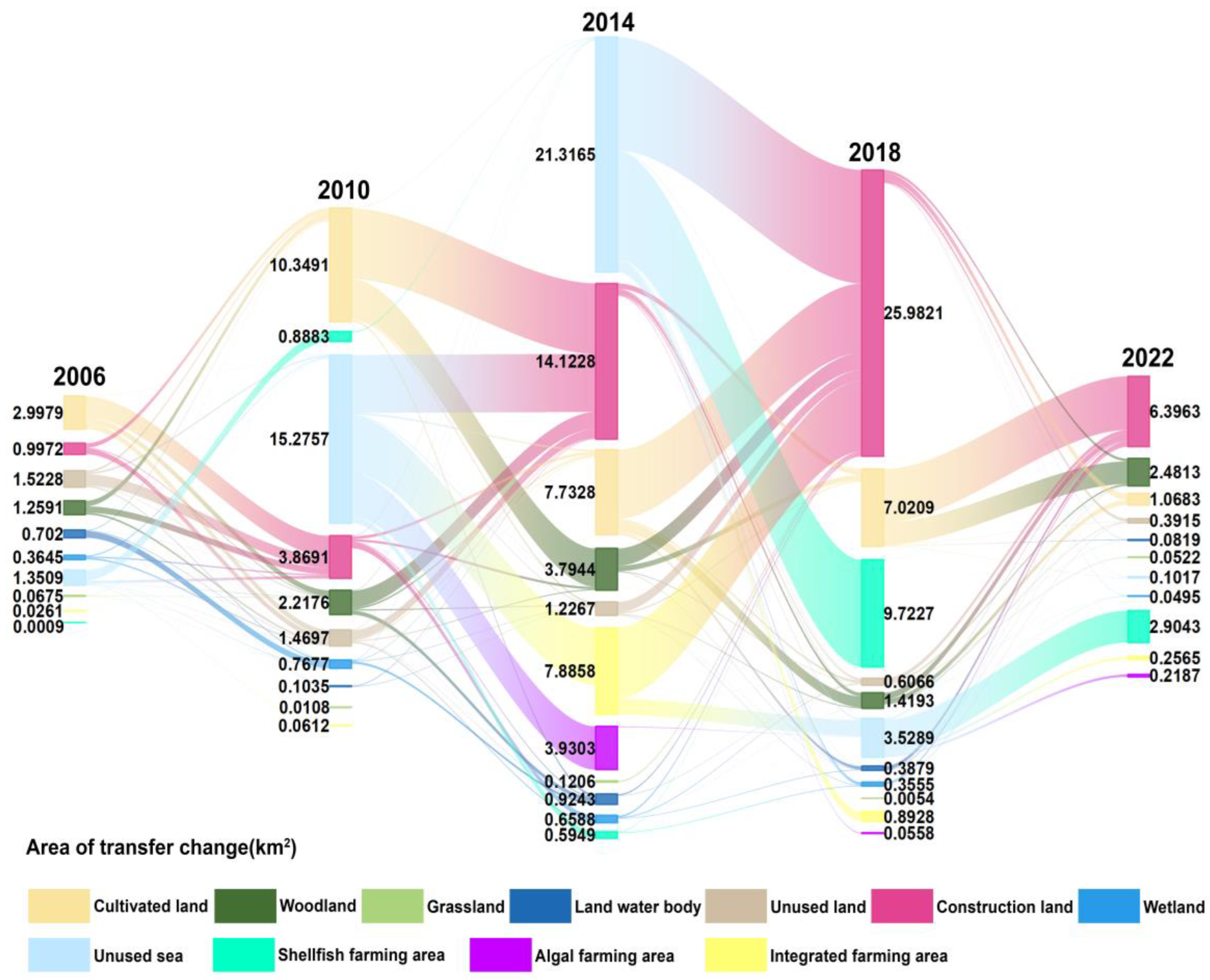
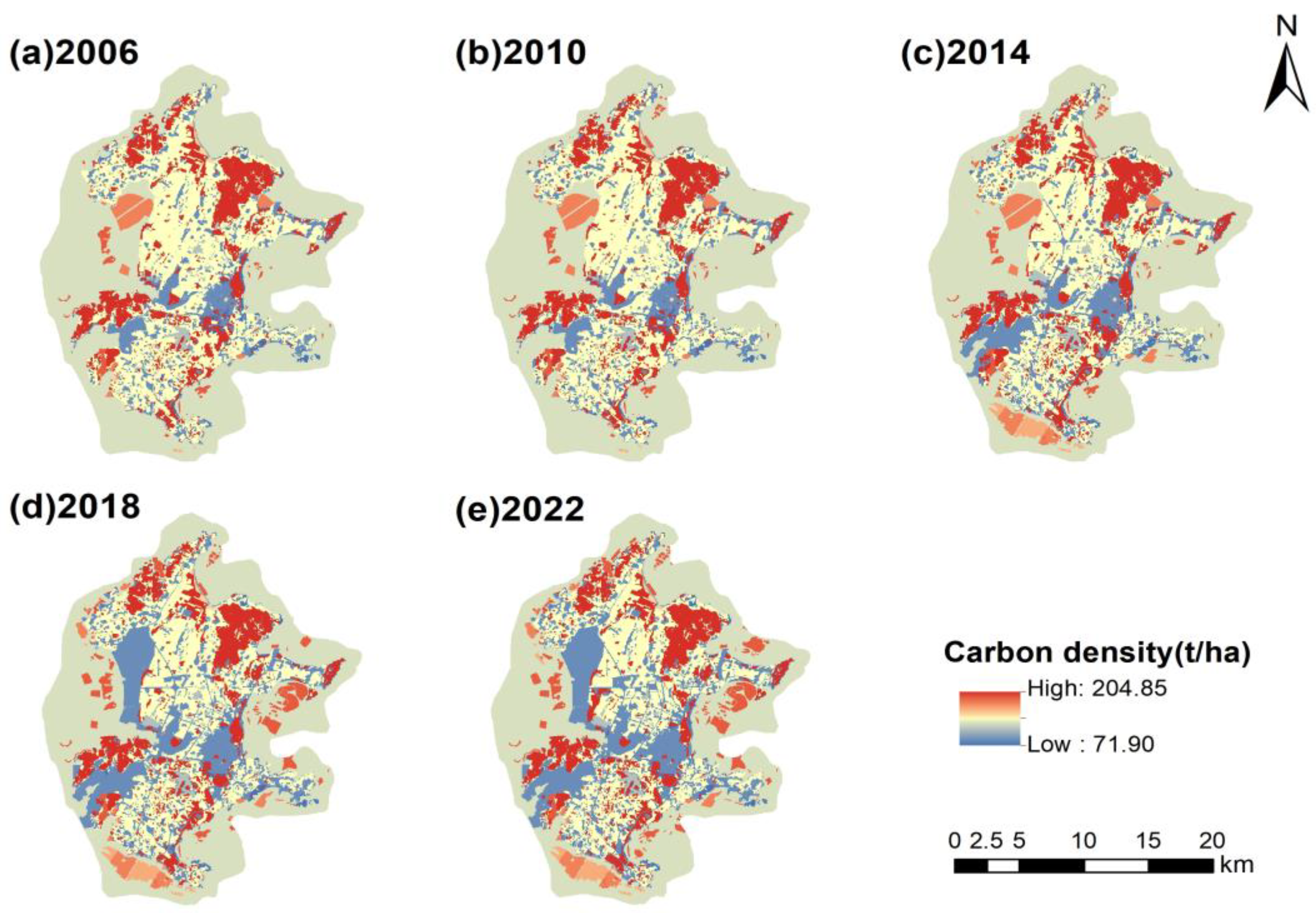
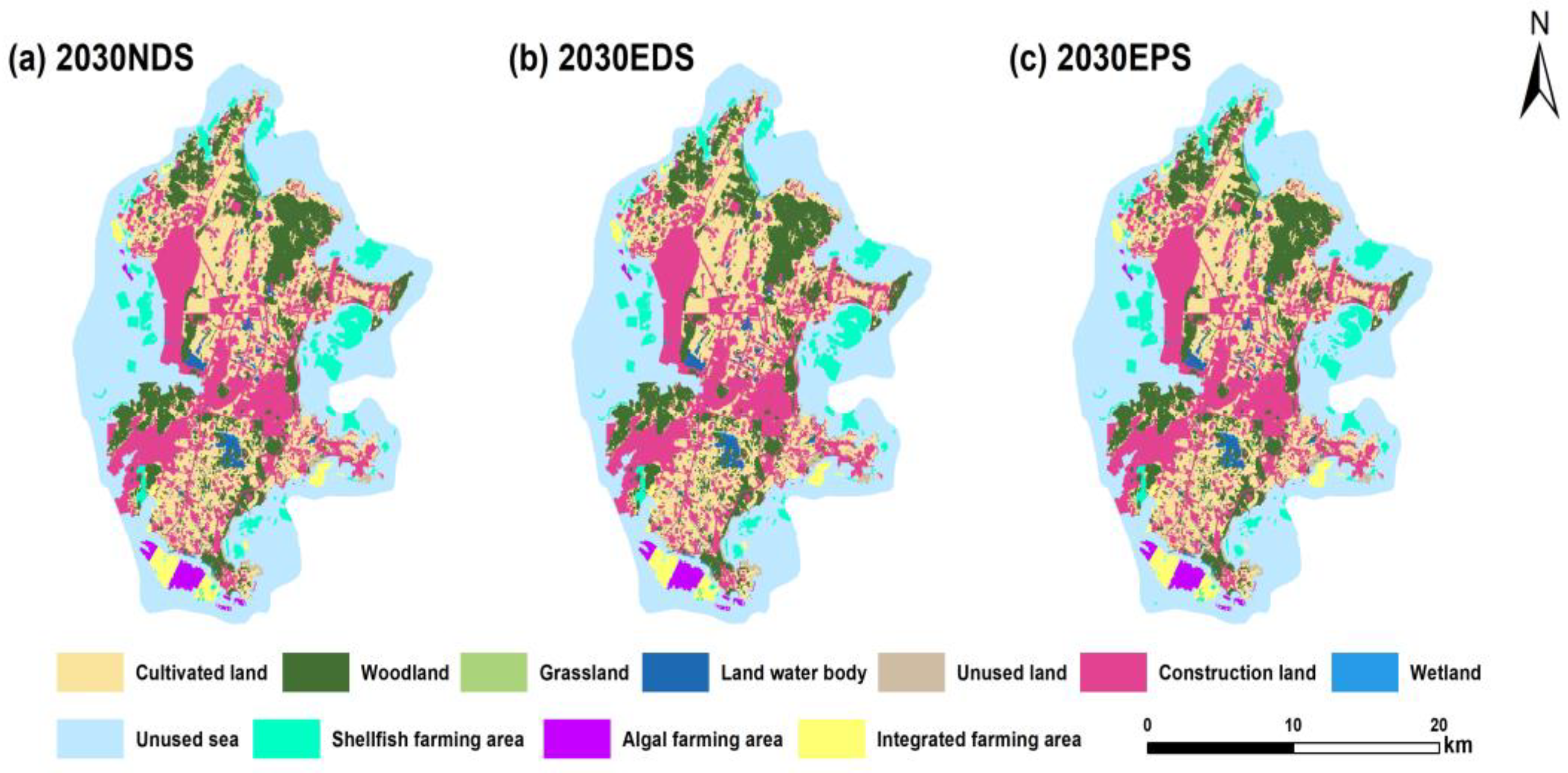

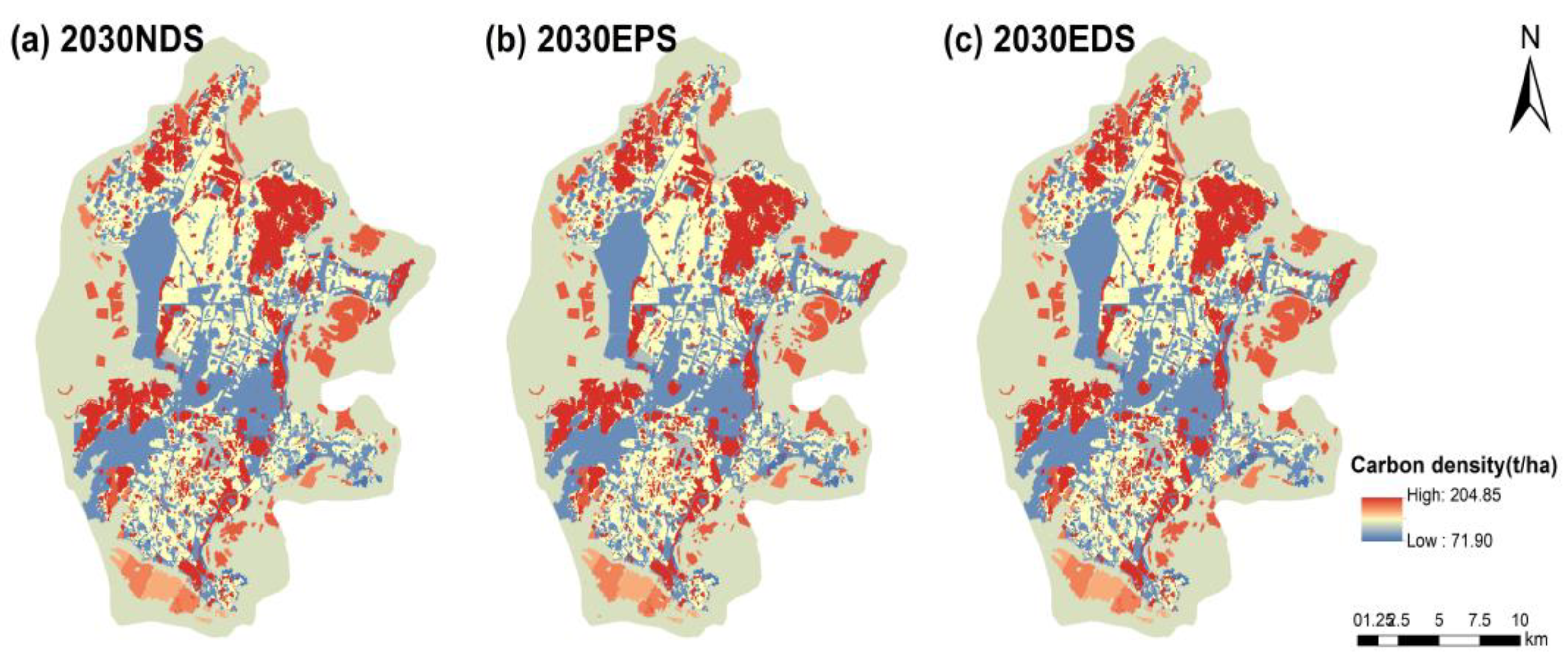
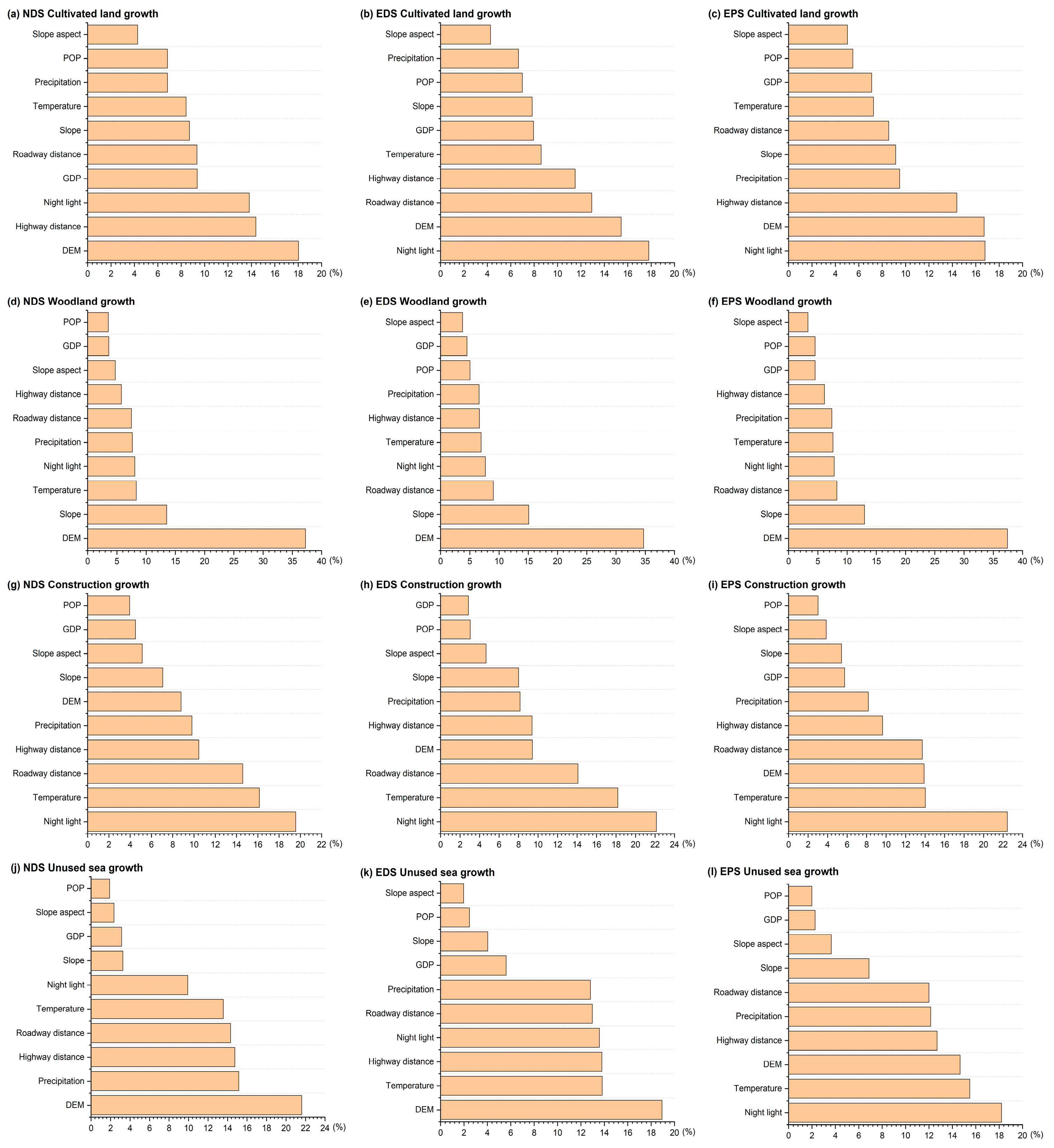
| Category | Data | Resolution | Data Resources |
|---|---|---|---|
| Natural Factors | DEM | 30 m | Geospatial Data Cloud (http://www.gscloud.cn, accessed on 12 January 2024) |
| Slope | 30 m | Generated by DEM in ArcGIS | |
| Slope direction | 30 m | ||
| Average annual temperature | 1 km | Center for Resource and Environmental Science and Data, Chinese Academy of Sciences (http://www.resdc.cn/data, accessed on 1 March 2024) | |
| Average annual precipitation | 1 km | ||
| Socioeconomic factors | Population density | 1 km | |
| GDP | 1 km | ||
| Nighttime lighting data | 0.004° | ||
| Distance from railroad | 30 m | National Center for Basic Geographic Information (http://www.ngcc.cn, accessed on 1 March 2024) | |
| Distance to highway | 30 m |
| Land Use Type | Cabove | Cbelow | Csoil | Cdead | Sources |
|---|---|---|---|---|---|
| Land water body | 0.00 | 0.00 | 94.60 | 0.00 | [53] |
| Cultivated land | 2.56 | 2.74 | 106.90 | 0.50 | [50,51,53,54] |
| Woodland | 55.20 | 15.40 | 127.30 | 6.95 | [50,53,54] |
| Grassland | 1.48 | 6.38 | 111.80 | 0.53 | [50,53,54] |
| Construction land | 0.11 | 0.00 | 75.40 | 0.00 | [53] |
| Unused land | 0.00 | 0.00 | 71.90 | 0.00 | [50,53] |
| Wetland | 5.74 | 5.47 | 77.65 | 0.00 | [50,51,53] |
| Land water body | 0.00 | 0.00 | 94.60 | 0.00 | [53] |
| Sea Area Utilization Type | Cben | Csed | Sources |
|---|---|---|---|
| Shellfish farming area | 0.22 | 156.00 | [45,61] |
| Algal farming area | 0.11 | 130.00 | [45,55,57] |
| Integrated farming area | 0.16 | 133.90 | [45,62] |
| Unused sea | 0.06 | 101.40 | [62] |
| Type | Conversion Factor (%) | Mass Weight (%) | Carbon Ratio (%) | ||
|---|---|---|---|---|---|
| Soft Tissue | Shell | Soft Tissue | Shell | ||
| Oyster | 65.10 | 6.14 | 93.86 | 45.98 | 12.68 |
| Mussel | 75.28 | 8.47 | 91.53 | 44.40 | 11.76 |
| Razor Clam | 64.21 | 11.41 | 88.59 | 42.82 | 11.45 |
| Kelp | 20 | 100 | 0 | 31.20 | 0 |
| Laver | 20 | 100 | 0 | 41.96 | 0 |
| Types of Island Utilization | 2006–2022 | 2022–2030 (NDS) | 2022–2030 (EDS) | 2022–2030 (EPS) | ||||
|---|---|---|---|---|---|---|---|---|
| Area (km2) | Dynamic Index (%) | Area (km2) | Dynamic Index (%) | Area (km2) | Dynamic Index (%) | Area (km2) | Dynamic Index (%) | |
| Cultivated land | −23.99 | −1.36 | −10.25 | −1.17 | −11.06 | −1.26 | −11.251 | −1.28 |
| Woodland | 1.688 | 0.16 | 2.472 | 0.48 | 2.335 | 0.45 | 3.332 | 0.65 |
| Grassland | −0.11 | −0.62 | −0.12 | −1.36 | −0.136 | −1.55 | −0.014 | −0.16 |
| Land water body | 0.06 | 0.07 | −0.56 | −1.38 | −0.557 | −1.37 | −0.504 | −1.24 |
| Unused land | −1.184 | −1.11 | −0.336 | −0.63 | −0.406 | −0.76 | −0.337 | −0.63 |
| Construction land | 45.826 | 3.19 | 9.384 | 1.31 | 10.444 | 1.45 | 9.052 | 1.26 |
| Wetland | 0.23 | 0.84 | −0.03 | −0.22 | −0.05 | −0.36 | −0.023 | −0.17 |
| Shellfish farming area | 13.906 | 4.73 | 5.634 | 3.83 | 5.634 | 3.83 | 5.633 | 3.83 |
| Algal farming area | 4.148 | 5.91 | −0.028 | −0.08 | −0.028 | −0.08 | −0.118 | −0.34 |
| Integrated farming area | −1.5 | −1.32 | 0.50 | 0.88 | 0.5 | 0.88 | 0.5 | 0.88 |
| Unused sea | −39.074 | −1.25 | −6.666 | −0.43 | −6.676 | −0.43 | −6.27 | −0.4 |
| Year | Carbon Storage on the Island (104 t) | |||
|---|---|---|---|---|
| Terrestrial Carbon Storage | Marine Carbon Storage | |||
| Benthic Organisms and Sediments | Phytoplankton | Fishery Algae and Shellfish | ||
| 2006 | 325.308 | 256.16 | 15.887 | 0.966 |
| 2010 | 323.870 | 256.545 | 13.705 | 1.110 |
| 2014 | 326.476 | 254.277 | 14.683 | 0.916 |
| 2018 | 335.997 | 239.956 | 12.508 | 1.257 |
| 2022 | 335.610 | 241.625 | 12.707 | 1.161 |
| 2030 (NDS) | 335.266 | 244.297 | 13.128 | 1.830 |
| 2030 (EPS) | 335.834 | 244.580 | 13.129 | 1.830 |
| 2030 (EDS) | 334.788 | 244.287 | 13.126 | 1.830 |
Disclaimer/Publisher’s Note: The statements, opinions and data contained in all publications are solely those of the individual author(s) and contributor(s) and not of MDPI and/or the editor(s). MDPI and/or the editor(s) disclaim responsibility for any injury to people or property resulting from any ideas, methods, instructions or products referred to in the content. |
© 2024 by the authors. Licensee MDPI, Basel, Switzerland. This article is an open access article distributed under the terms and conditions of the Creative Commons Attribution (CC BY) license (https://creativecommons.org/licenses/by/4.0/).
Share and Cite
Chen, S.; Xu, M.; Lin, H.; Tang, F.; Xu, J.; Gao, Y.; Zhuang, Y.; Chen, Y. A Spatial–Temporal Analysis and Multi-Scenario Projections of Carbon Sequestration in Sea Islands: A Case Study of Pingtan Island. J. Mar. Sci. Eng. 2024, 12, 1745. https://doi.org/10.3390/jmse12101745
Chen S, Xu M, Lin H, Tang F, Xu J, Gao Y, Zhuang Y, Chen Y. A Spatial–Temporal Analysis and Multi-Scenario Projections of Carbon Sequestration in Sea Islands: A Case Study of Pingtan Island. Journal of Marine Science and Engineering. 2024; 12(10):1745. https://doi.org/10.3390/jmse12101745
Chicago/Turabian StyleChen, Siyu, Ming Xu, Heshan Lin, Fei Tang, Jinyan Xu, Yikang Gao, Yunling Zhuang, and Yong Chen. 2024. "A Spatial–Temporal Analysis and Multi-Scenario Projections of Carbon Sequestration in Sea Islands: A Case Study of Pingtan Island" Journal of Marine Science and Engineering 12, no. 10: 1745. https://doi.org/10.3390/jmse12101745
APA StyleChen, S., Xu, M., Lin, H., Tang, F., Xu, J., Gao, Y., Zhuang, Y., & Chen, Y. (2024). A Spatial–Temporal Analysis and Multi-Scenario Projections of Carbon Sequestration in Sea Islands: A Case Study of Pingtan Island. Journal of Marine Science and Engineering, 12(10), 1745. https://doi.org/10.3390/jmse12101745






